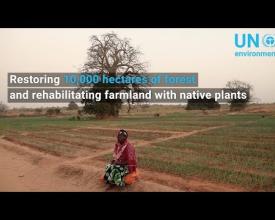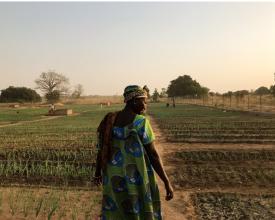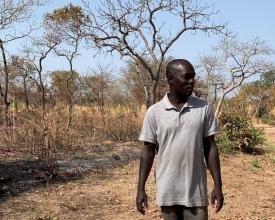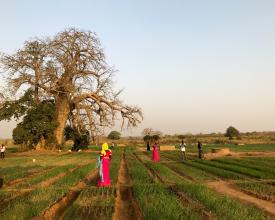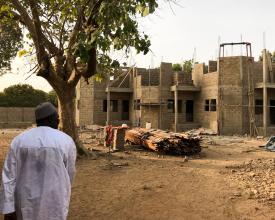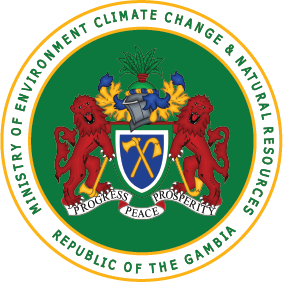
Large-scale Ecosystem-based Adaptation in the Gambia river basin: Developing a climate-resilient, natural resource-based economy
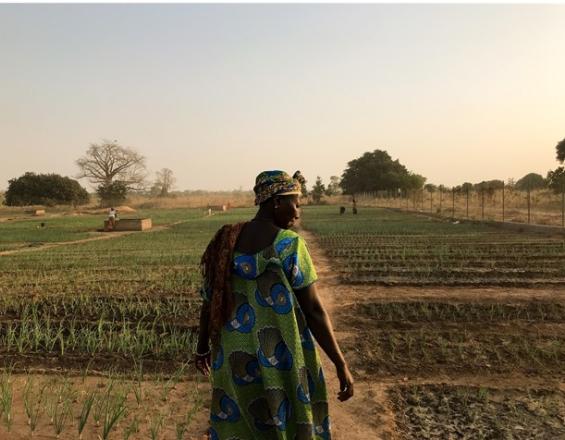
The consequences of climate change in the Gambia are stark and Gambians are extremely vulnerable. Increased temperatures, wind storms, coastal erosion, erratic rainfall, droughts, and floods have intensified, resulting in reduced agricultural and livestock production and unsustainable extraction of resources from forest ecosystems by rural households.
UNEP is supporting The Gambia’s government with Gambia’s largest adaptation project. Funded by the Green Climate Fund, the aim is of this large-scale Ecosystem-based Adaptation (EbA) intervention is to build climate resilience over large areas and promote climate-resilient sustainable development. This is achieved firstly by restoring degraded ecosystems, including forests, mangroves and savannahs, and agricultural landscapes with climate-resilient plant species that provide goods for consumption or sale; and secondly, by facilitating the establishment of natural resource-based businesses and management committees to manage the Gambian natural resource base sustainably.
Context
Challenges addressed
The Gambia is extremely vulnerable to climate change consequences regarding temperature and water. To protect Gambians and their livelihoods from these negative impacts and increase resilience, the focus lies on restoring degraded ecosystems and agricultural landscapes. The main challenge in this restoration endeavour however has been the low availability of adequate and viable seedlings and threats to their survival. These were the main challenges:
- the low survival rate of the seedlings due to insufficient numbers of seed banks to store viable seeds for future uses, not enough tree nurseries nor nursery attendants.
- lack of appropriate technology for ascertaining the viability of the selected seedlings
- human activities, such as bushfires, cooking, and illegal logging as well as limited knowledge on the movement and ranging patterns of large herbivores threaten the survival of the young seedlings planted
- extreme climatic conditions that necessitate a high level of water usage to irrigate the seedlings.
Location
Process
Summary of the process
The first building block should be the first step. Assessing the number of adequate seeds and resources available is crucial, to then determine if the construction of new nurseries or gene banks is necessary or not. This will guarantee that you will have the necessary quantity of seeds to start implementing the project and match the objectives.
Then, it is key to determine what could reduce the survival rate of the seedlings, once planted, and elaborate appropriate solutions, like the adaptation and mitigation measures highlighted in building block 2. Adding these activities and selecting only appropriate restoration and agricultural techniques is very important to protect seedlings from the negative impacts of climate risks, human activities, and other factors.
Only then creating economically viable natural-resources-based businesses (building block 3) is promising and can foster sustainable long-term income.
Building Blocks
Constructing new plant nurseries and genes banks
One of the main challenges was the low availability of adequate and viable seedlings. To overcome this challenge, the project began constructing new tree nurseries, which were all developed during 2019 and became fully operational during 2020 with the construction of 900 seedbeds. Instead of one nursery per region, as it was initially planned, the project was recommended to construct nine (9) nurseries altogether as part of the strategy to meet the 10,000 hectares restoration target or slightly more. To sustain these nurseries, the project recruited 18 Nursery Attendants (two per nursery).
The nurseries aim to increase available planting materials to supply the EbA interventions and for use by communities outside the scope of the project. The project also developed long-term business plans and revenue models to support sustained operations of expanded/created nursery facilities.
In addition, six (6) Forest Stations were refurbished as part of the nursery infrastructure.
UNEP is also working with the Department of Forestry to explore low-cost options to establish small gene banks for use by the project and beyond the lifetime of the project. With the construction of these nurseries, adequate seedlings are and will be available throughout the year.
Enabling factors
Enough financial and water resources to build and run the structures are needed. To build sustainable and efficient nurseries, the choice of the seeds is crucial (prior assessment recommended) and nursery attendants need to be hired. To sustain the nurseries, long-term business plans and revenue models to support activities of the nurseries should be developed.
Finally, it's key to involve the local communities and authorities in the construction and management of the nurseries and explain the economic, environmental, and social benefits of such nurseries.
Lesson learned
- To ensure the adequate quantity and type of seeds, the construction of additional nurseries might be required.
- An adequate number of nursery attendants is needed for the successful management of the nurseries.
- If establishing a new nursery, it is crucial to diversify the types of seedlings. Constructing a gene bank can be an effective means to achieve this.
- Large-scale restoration work requires an adequate seed bank or gene bank more broadly to store and manage seeds/planting materials of different climate-resilient species involved.
- Climate-resilient species preference and numbers to be planted need to be determined beforehand and allocation decisions should be within an agreed criterion as the number of seedlings may not satisfy demand or planting locations which affect project delivery.
Adopting mitigation measures to reduce the impact of climate risks
Based on the results of baseline studies that determined climatic risks, different ecosystem-based adaptation and mitigation measures were identified and individual farmers and community-based organizations were incentivized to lead the various activities through diverse training (led by World Agroforestry (ICRAF)); including:
- The establishment of a two-meter-wide fire belt around all preferred mother trees, large trees within a forest that act as centralized hubs, supporting communication and nutrient exchange amongst trees.
- Farmer-managed tree growing approach, named Zai Pits, half-moon planting pits, which farmers create in the hardpan soil using hand tools or plows and animals. These act as micro-water catchments, holding about four times the amount of water that normally runs off the land but also compost, thereby increasing production.
- Adding water-buffering vegetation around the runoff water collection reservoir to reduce wind flow over the reservoir and thus reduce evaporation from the system. The system also facilitates reduction in runoff and enhances groundwater recharge through infiltration.
- Rainwater harvesting, storage, and distribution techniques were implemented to support the restoration efforts and overcome the shortage in water resources due to extreme weather conditions and low rainfall.
Enabling factors
It is crucial to conduct baseline studies to determine the climatic risks, and then select adequate adaptation and mitigation measures, in light of local specificities. To choose the most appropriate and effective measures, access to enough knowledge from national and local sources (indigenous communities, national institutes, and ministries, local NGOs, etc) is key, and enough financial resources, human resources, and time should be allocated to the implementation of these measures.
Lesson learned
- By applying the correct planting or restoration method, such as assisted natural regeneration and having adequate access to resources, the survival rate went from 10-48% to almost 95% after three months of planting. Now these measures are being replicated in other community-owned forests and community-protected areas (CPAs).
- Constraints, other than genetic and/or climatic, should be carefully explored and addressed to increase the survival rate of seedlings (e.g., bushfire, water shortage, grazing by wild and/or domestic animals including those coming through seasonal transhumance, etc)
- In certain regions, there is only a short rainy season. Seedlings that are planted late in the rainy season can therefore struggle to survive the long season and the heat.
- To increase the survival of the seedlings, measures such as the establishment of a fire-belt, or the use of water-buffering vegetation, might be required.
- The adoption of farmer-managed tree growing approaches and the establishment of rainwater harvesting structures at the project sites might be necessary for an effective large-scale restoration.
Promoting climate-resilient natural resource-based economy and businesses
The project increases the generation of ecosystem goods and services and promotes the establishment of commercially viable natural resource-based businesses managed by local communities. To establish such businesses, the project conducted a baseline study including an assignment on the Economics and Market Analysis for establishing financially viable natural resource-based businesses in the Gambia. The report proposed 7 potential business portfolios and defined the financial implications of these natural resource-based businesses for the contributions to the National Forest Fund (NFF) through a detailed discounted cash flow analysis. One such activity to facilitate the establishment of these businesses was the introduction of bee-fodder tree species to support bee farming in the community-owned forests and community-protected areas (CPAs).
The project also facilitated the integration of the EbA approach and natural resource-based businesses into existing government plans and activities and demonstrated and quantified their commercial viability to promote further investment by the government and the private sector beyond the project implementation period.
Enabling factors
Access to enough natural resources is important and requires, if not available, restoration and related activities to ensure availability.
Enough funding is key to build the required infrastructure and start the business.
For the businesses to be economically viable and attractive for local people, they need to stem from participatory processes and answer community needs. Technical guidance and training to the population can support the process.
Having support from the government and environmental agencies is helpful.
Lesson learned
Providing capital only is not enough to develop successful natural resource-based enterprises. A more holistic, capacity development approach is needed. To achieve sustainability and impact, it is crucial to adopt participatory approaches to incentivize community members to take part in the activities.
The importance of implementing natural resource-based businesses through suitable business models implies the development of a business culture along the value chains of forest products to facilitate value addition and link producers and vendors to input and output markets. This requires:
- Developing appropriate institutional arrangements to extend credit to actors in the Small and Medium Forest Enterprises (SMFEs); create awareness among value chain actors of appropriate financial sources, and establish credit guarantee schemes for producers and cooperative organizations.
- Developing and improving the knowledge of market information systems and quality control measures and standards.
- Strengthening community-based organizations of SMFEs to access services and facilitate their partnership with private sector entities.
Impacts
So far, EbA activities cover 7,770 ha. This includes 4,403.5 ha of degraded lands rehabilitated (including 250ha of mangroves, which act as buffer zones from storm surges and floods, and 456.7ha of agricultural lands across 251 farm holdings), and 125.6kms of fire belts with a width of 10 meters established across all regions to protect the restored areas. No incidences of fires were subsequently reported across the protected areas during the period under review. The project also added water-buffering vegetation around the runoff water collection reservoir to reduce wind flow over the reservoir and thus reduce evaporation from the system. The system also facilitates reduction in runoff and enhances groundwater recharge through infiltration.
30 beekeeping businesses equipped with 300 beehives (10 per community) have been established. The 30 beekeeping businesses have created 398 jobs, 121 of these filled by women. The project also carried out significant business plan development and is commencing implementation of other natural resource-based enterprises focused on eco-tourism, andropogon harvesting, and wildlife farming.
Finally, ecosystem-based concepts have been integrated into two national-level policies: i.e., the agricultural five-year extension policy, and the Rural Development Policy. A total of $11.3m will be raised over 20 years for the National Forest Fund from taxes and licensing fees.
Beneficiaries
The project is benefiting up to 11,550 Gambian households directly and 46,200 households indirectly in four regions along the Gambia River. It includes women, farmers, local populations, coastal populations, and natural resource-based businesses.
Sustainable Development Goals
Story
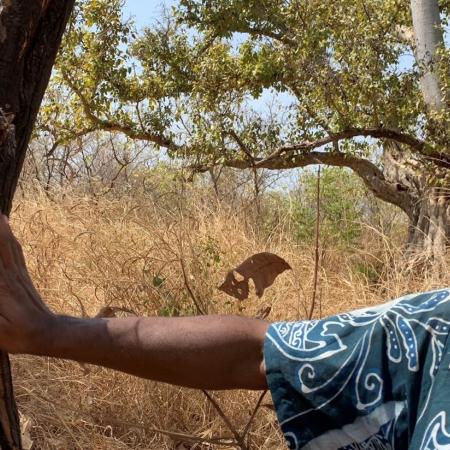
Batelling village, located in the lower river region of The Gambia, next to Kiang West National Park, faces many challenges: “Previously we had the fruits of ‘duto’, ‘kaba’ and ‘neto’; now wild fruits are almost extinct,” said villager Mamodou Sanyang. The former park ranger added that droughts had started five years ago, and bush fires were now more frequent. "Droughts came because of a shortage of trees. When I was young, we could go five years without a fire.”
Mother of nine, Sustayring Jang, adds, “millet harvests are diminishing and raids by primates are now routine.”
But they believe solutions are emerging under a project they call ‘EbA’. “We are going to enrich the forest in the park with edible wild plants,” says Lalisa Duguma, a senior researcher from the World Agroforestry. ‘This will reduce human-wildlife conflict. The forest around here is very degraded, and monkeys are missing what to eat. It has become a fight for survival for them too.”
After consultations with village members and the wildlife department, fire was identified as the major impediment.
By solving the problem of fire, the project potentially solves the raiding monkeys and loss of wild food, upon which 48% of rural Gambians rely, according to the baseline survey. And, in the future, the resurgent forest might even bring more rain.
The villagers are quietly euphoric. The project paid them to cut a firebreak and clear the vegetation around key species of trees. And in a major victory, the fire that used to scare them every dry season did not cross the firebreak. “Previously we used to be threatened but this year fire was contained. Due to lack of fire, there will be more fruit,” says Jang.
“EbA is really good,” says Mamodou. “It has created a fire belt to prevent fire intrusion and one of the benefits of not having fire is that animals will have an opportunity to eat the fruit and that’s a relief for them.”
Clearing vegetation from around key species also helps as “this tackles the fuel load on the soil surface. Within the same space, we also clear the tall elephant grass that connects the ground to the tree canopy to prevent the vertical expansion of flames engulfing it. Clearing the ground also protects young seedlings around mother trees. And when we created this 10-meter fire strip, the fire had nothing to feed upon and finished here,” he says, pointing to a line on the ground. “The park did not burn. Now we will get natural regeneration of trees.”

